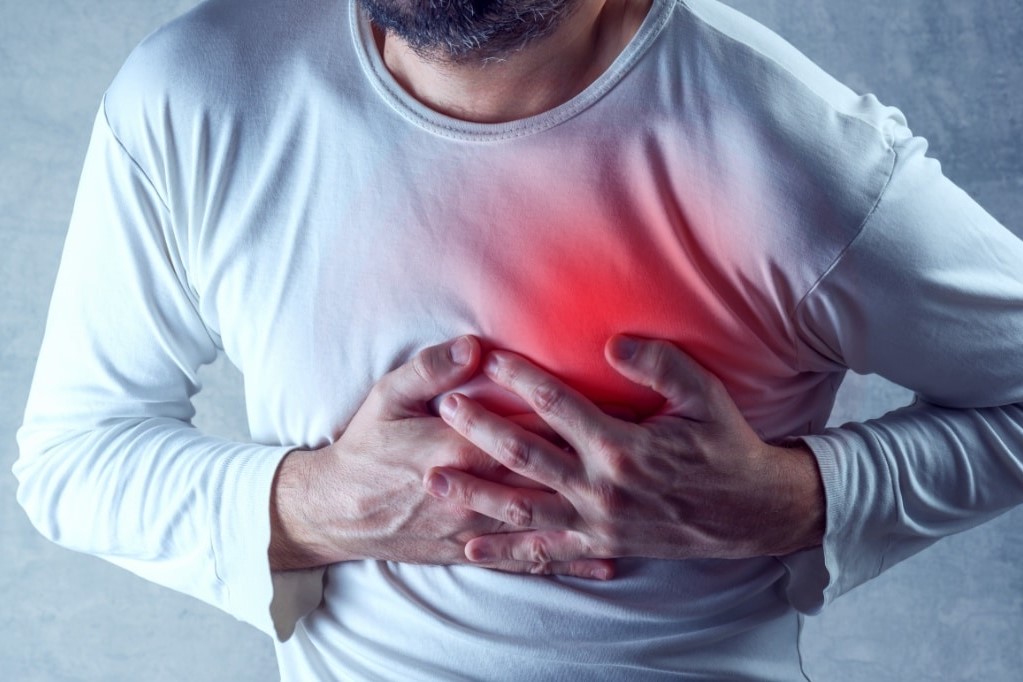
Angina pectoris: recognition, diagnosis and treatment
Angina pectoris can be the expression of a narrowing of the coronary arteries and the warning sign of a myocardial infarction
Angina pectoris is a syndrome that, as the Latin words indicate, manifests itself with oppressive pain in the chest or radiating down the back, left arm, neck and jaw.
This may be accompanied by a number of neurovegetative reactions, such as cold sweats and nausea.
The causes of angina pectoris
Chest pain, or angina pectoris, results from a reduced supply of blood and oxygen to the heart, in most cases due to narrowing of one or more coronary arteries (the arterial vessels that bring blood and nutrition to the heart).
These stenoses, which are significant when they exceed 70% of the blood vessel, are caused by atherosclerosis, the accumulation of lipids within the walls of the coronary arteries.
Stable and unstable angina pectoris
There are two main types of angina pectoris that can occur:
- stable angina: occurs when a patient, who has a significant stenosis (narrowing) of one of the coronary arteries, is walking, running or exerting themselves, i.e. when the demand for oxygen from the heart increases;
- unstable angina: symptoms that begin at rest, or with gradually decreasing exertion. This is a more serious clinical condition, requiring more urgent intervention than stable angina.
When to worry
Angina pectoris can lead to myocardial infarction, i.e. death of part of the heart tissue due to no or excessively low blood supply to that area.
Chest pain is a symptom that should always put us on the alert, especially in people most at risk: men (affected more than women, who are not exempt), middle-aged or older, who have the main risk factors
- hypertension;
- high cholesterol levels;
- diabetes;
- family history of ischaemic heart disease (first degree relatives who have had heart attacks or heart disease at a young age);
- cigarette smoking;
- overweight.
What to do if you have a heart attack
Patients who have one or more risk factors and who experience chest pain of an oppressive type, central in the chest, perhaps radiating and associated with algid sweating, should call their family doctor and, in the case of persistent and prolonged pain, contact emergency number.
This activates the so-called heart attack network, a process that enables
- an initial diagnosis directly at the patient’s home,
- the execution of an ECG sent to the local coronary units, which are alerted to carry out primary angioplasty to revascularise the blocked artery in a very short time.
Diagnostic tests required if angina pectoris is suspected
If you have had episodes of chest pain, you should report them to your general practitioner, who may prescribe a cardiological examination.
The recommended tests are
- ECG at rest
- echocardiogram (ultrasound of the heart);
- provocative tests, such as the stress test.
These examinations look for any indirect signs of cardiac ischaemia, represented by specific alterations in the electrocardiogram or ultrasound.
Second level examinations
If the stress test gives a doubtful or inconclusive result, there are second-level examinations, such as
- myocardial scintigraphy, to study cardiac function, with administration of a radiopharmaceutical;
- cardiac stress MRI (with injection of drug and contrast medium);
- coronaroTAC, a tomographic examination that evaluates the anatomy, useful for seeing narrowing of the coronary arteries.
If one of these tests is positive, the patient undergoes coronarography, the gold standard for detecting narrowing of the coronary arteries.
Treating angina pectoris
When coronary insufficiency is diagnosed, medical therapy consisting of antiplatelet drugs, beta-blockers, ACE inhibitors and statins must be started and then, depending on the clinical picture, interventional cardiology and possibly cardiac surgery must be performed.
Through the interventional cardiology procedure, coronarography, it is possible to check whether the coronary arteries are clear: this is a minimally invasive examination that involves inserting a catheter through the radial or femoral artery and, by injecting a contrast medium, assessing any narrowing.
ECG EQUIPMENT? VISIT THE ZOLL BOOTH AT EMERGENCY EXPO
Angioplasty and stenting
Depending on the number and location, it may be decided to treat them in the same procedure, by dilating the vessel with a balloon, angioplasty, and applying a stent, a metal mesh medicated with drugs that tend to hinder the hyperproliferation of the vascular endothelium.
The by-pass
In patients whose disease is very extensive and involves several coronary branches, or whose anatomy is unfavourable to percutaneous treatment, surgery is used to create a by-pass, a conduit created by taking the saphenous vein or using the patient’s mammary artery.
Silent infarction
Angina pectoris is one of the pre-infarct symptoms, but there are also cases in which the heart attack occurs asymptomatically.
These are the so-called silent infarctions, those that are detected after the event: during an occasional check-up, or due to respiratory fatigue, a scar is discovered on the heart, a sign of a previously closed coronary artery, without any symptoms.
This case is more frequent in diabetic patients, who often do not feel cardiac pain.
Prevention of angina pectoris
Atherosclerotic disease is a progressive disease that never goes backwards: either it is stabilised or, over time, it will tend to progress.
It is therefore essential to pay close attention to lifestyle and the treatment of risk factors, which must be kept in mind when managing therapy:
- reduce body weight;
- moderate levels of aerobic physical activity;
- take the prescribed therapy regularly;
- abstaining completely from smoking;
- treating diabetes carefully.
Read Also:
Inflammations Of The Heart: Myocarditis, Infective Endocarditis And Pericarditis
MRI, Magnetic Resonance Imaging Of The Heart: What Is It And Why Is It Important?
Cardiovascular Diseases In Women: What They Are And What They Are Due To


